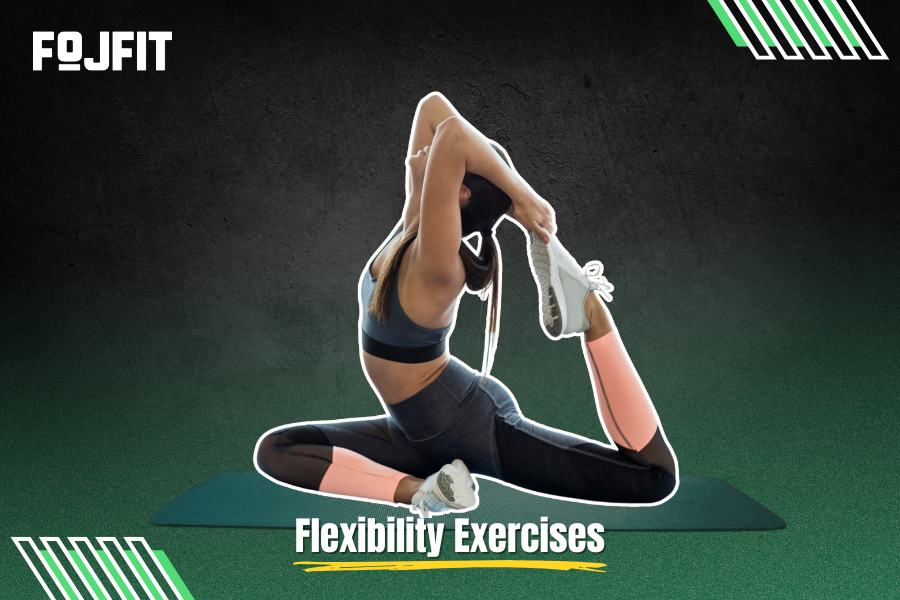Read Our Latest Blogs
Read about science-backed fitness facts, healthy eating habits, workout tips and tricks, nutritional foods, and more. Your one-stop shop to stay updated with in-vogue fitness trends.


It is often noticed that despite having a well-toned body, some individuals still struggle to attain peak fitness. While most people focus on building muscle and endurance, an important aspect of physical fitness that is often overlooked is flexibility. Achieving optimal physical condition is not just about being able to touch your toes, rather it’s about enhancing your overall physical performance and reducing the risk of injury.
Flexibility is a vital factor in improving the overall body movement of an individual while building strength and stability. When it comes to preparing for a career in defence, flexibility training combined with your normal fitness routine is strongly advisable. A well-structured flexibility training usually involves dynamic stretching and flexibility exercises that help you to perform movements effortlessly. In this article, we will explore the various aspects of flexibility exercises, their health benefits, and the best practices of flexibility training.
Why are flexibility training essential for defence candidates?
Flexibility is a vital factor in enhancing the physical performance of defence candidates as it helps maintain proper posture and balance during demanding activities. Incorporating Flexibility exercises for defence aspirants into a regular fitness regimen, can not only boost your physical performance but also contributes to overall well-being.
Health Benefits of Flexibility Training
Improved flexibility produces a wide range of health benefits and can have a positive effect on your overall well-being. Here are a few ways that increased flexibility is likely to help you.
1. Improved body movement
Once you increase your flexibility, you can perform and execute various movements efficiently. By performing flexibility exercises your muscles work more effectively.
2. Reduce Injury
By incorporating stretching and flexibility exercises into your regular fitness routine, you can improve your muscle elasticity thereby preventing injuries effectively and reducing risks of strains and sprains. For example, it is always advisable to add different stretching exercises such as cat-cow, hamstring stretch, standing calf stretch or simple baby stretching after high-intensity workout sessions.
3. Enhanced performance
While you are engaged in demanding physical activities like running, jumping, or climbing, flexibility can boost your performance. Improved flexibility such as dynamic stretching allows for better movement of your body parts which results in performing tasks with less effort.
4. Improve posture and balance
If you are aiming to maintain stability and improve posture, flexibility training can help you strengthen your core and stabilise muscles. Yoga is one of the best flexibility training that has been shown to improve balance.
5. Enhanced strength
Building strength is always essential once you aim to become more flexible. Flexibility exercises ensure your muscles will have the right amount of tension so that they’re strong enough to support you and your movements, allowing you to become more physically fit.
Best Practices for Flexibility Training
1. Warm-Up First
It is always advised to begin your fitness training routine with a proper warm-up to increase blood flow to your muscles. This can include light aerobic activities like jogging, marching or jumping jacks for about 5-10 minutes.
2. Dynamic Stretching before workouts
It is always recommended to incorporate dynamic stretches such as shoulder stretches, leg swings or bicep stretches that allow your muscles to prepare for the high-intensity workout training.
3. Static Stretching after workouts
After your regular workout session, incorporate static stretching. Try to hold each stretch for 15-30 seconds, focusing on major muscle groups like hamstrings, quadriceps, and shoulders. This helps improve flexibility and promotes recovery effectively.
4. Being Consistent
Try to incorporate flexibility training into your fitness routine at least 2 times a week. Consistency is the key that can provide the best results over time.
5. Always listen to Your Body
Flexibility is a distinguishing physical aspect that varies from person to person. As you listen to your body by paying attention to it, you can protect yourself from discomfort and pain.
6. Focus on Different Techniques
Try to incorporate various forms of flexibility training into your regular fitness routine such as yoga or Pilates. Adding varieties of these exercises can provide additional benefits like improved balance, posture, and core strength.
Conclusion
There is always a thin line between being fit and being flexible. Whether you are an aspiring defence candidate or simply aiming to achieve peak physical fitness, adding well-curated flexibility training along with a regular workout session is a crucial step. Always remember to begin with the basics, stay consistent, and you'll notice visible results in no time. Remember, flexibility is not just about being agile, it's about preparing your body for success!

An ADC to any higher official is expected to possess a few very important skills, that includes organizational skills, c...
25 April 2024
If you are looking for a perfect solution that can help you shed weight efficiently, learn how to burn calories fast at...
15 October 2024
These effective and expert-designed Military style workouts into a defence candidate’s fitness routine can help build up...
18 September 2024